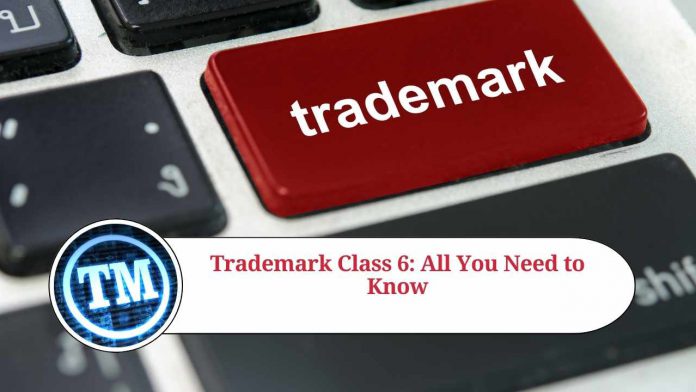Trademark Class 6: A Comprehensive Guide
When it comes to registering a trademark, it’s essential to determine which trademark class your goods or services fall under. The International Classification of Goods and Services is a system that categorizes goods and services into 45 classes. In this article, we’ll focus on Trademark Class 6, which includes goods made of common metals and their alloys.
What is Trademark Class 6?
Trademark Class 6 includes a wide range of goods made of common metals and their alloys, including unwrought or semi-wrought metals, pipes, and tubes made of metal, metal castings, locks, safes, and other metal hardware, and small items of metal hardware. This class also includes goods made of metal foil and powder, as well as metal building materials, such as building frameworks, doors, and windows.
What are the types of goods classified under Class 6?
Trademark Class 6 includes a wide range of goods made of common metals and their alloys. Some of the most common types of goods classified under this class include:
- Metal pipes and tubes
- Metal safes and cash boxes
- Metal building materials, including doors and windows
- Common metals and their alloys
- Metal castings
- Metal locks and keys
- Metal containers for storage or transport
- Small items of metal hardware, such as nails and screws
- Metal foil and powder
- Metal wire goods
Why is it important to register under Class 6?
Registering under the appropriate trademark class is essential to ensure that your trademark is protected against potential infringers. By registering under Class 6, you can ensure that your trademark is protected for goods made of common metals and their alloys. This can be particularly important if your business involves the manufacture or sale of metal products.
What are the other classes related to Class 6?
Trademark Class 6 is closely related to several other trademark classes, including:
- Class 9: Electrical and Scientific Apparatus – this class includes electronic locks and safes, which are often closely related to metal locks and safes classified under Class 6.
- Class 17: Rubber, Gutta-Percha, and Plastic – this class includes rubber and plastic goods, which may be used in combination with metal goods classified under Class 6.
- Class 19: Non-Metallic Building Materials – this class includes non-metallic building materials, such as doors and windows made of plastic or wood, which may be used in combination with metal building materials classified under Class 6.
How to Register a Trademark under Class 6?
If you wish to register a trademark under Class 6, you must follow the following steps:
- Conduct a Trademark Search: Conducting a trademark search is the first and foremost step. It helps you to determine if your trademark is unique and not already registered or being used by another entity. It is essential to avoid any legal disputes later on.
- Choose the Appropriate Trademark Class: Once you have conducted a trademark search, the next step is to choose the appropriate trademark class. In this case, you need to select Trademark Class 6 as it pertains to goods made of common metals and their alloys.
- File the Trademark Application: Once you have determined the trademark class, you need to file a trademark application with the relevant authority in your jurisdiction. In the US, you can file your trademark application with the United States Patent and Trademark Office (USPTO).
- Pay the Application Fee: You must pay the application fee while filing the trademark application. The application fee varies depending on your jurisdiction.
- Wait for the Trademark Registration: Once you have filed the trademark application, you need to wait for the trademark registration. It may take several months to receive the trademark registration. In the US, it takes around six to eight months to receive a trademark registration.
Benefits of Registering a Trademark under Class 6
- Protection against Infringement: Registering a trademark under Class 6 gives you exclusive rights to use the trademark for goods made of common metals and their alloys. It also protects your trademark against potential infringers.
- Brand Recognition: Registering a trademark under Class 6 helps you to build brand recognition and increase the value of your brand.
- Legal Protection: Registering a trademark under Class 6 provides you with legal protection against potential infringers. You can take legal action against anyone who tries to infringe on your trademark rights.
- Increased Business Opportunities: Registering a trademark under Class 6 can open up new business opportunities for you. You can license your trademark to other entities and earn royalties.
Conclusion
Trademark Class 6 pertains to goods made of common metals and their alloys. It is essential to register your trademark under this class if your business involves the manufacture or sale of metal products. By registering your trademark under Class 6, you can protect your intellectual property rights and build brand recognition. Follow the steps mentioned above to register your trademark under Class 6 and enjoy the benefits of trademark protection.
Read more useful content:
Frequently Asked Questions (FAQs)
What goods fall under Trademark Class 6?
Trademark Class 6 includes a wide range of goods made of common metals and their alloys, such as metal pipes and tubes, metal safes and cash boxes, metal building materials, metal castings, metal locks and keys, metal containers for storage or transport, and small items of metal hardware, among others.
Can I register my trademark under multiple classes?
Yes, you can register your trademark under multiple classes if your goods or services fall under different categories. However, you will need to file separate trademark applications for each class and pay the associated fees.
How long does it take to register a trademark under Class 6?
The time it takes to register a trademark under Class 6 may vary depending on your jurisdiction. In the US, it takes around six to eight months to receive a trademark registration.
What is the validity of a trademark registration under Class 6?
Trademark registrations under Class 6 are valid for ten years from the date of registration. After ten years, you can renew your trademark registration by filing a renewal application.
Can I amend my trademark application after filing it?
In most cases, you can amend your trademark application after filing it if you want to make any changes to your trademark. However, you may need to pay additional fees to make these changes.
Do I need a lawyer to register my trademark under Class 6?
No, you don’t need a lawyer to register your trademark under Class 6. However, it’s advisable to seek legal advice if you’re unsure about the trademark registration process or if you need help with filing your trademark application.
Can I use my trademark before it’s registered?
Yes, you can use your trademark before it’s registered. However, your trademark registration will provide you with legal protection against potential infringers.
What is a trademark search, and why is it essential?
A trademark search is a process of checking if your trademark is unique and not already registered or being used by another entity. It’s essential to conduct a trademark search to avoid any legal disputes later on.
Can I transfer my trademark ownership to someone else?
Yes, you can transfer your trademark ownership to someone else by assigning your trademark rights. However, you will need to file an assignment application and pay the associated fees.
Can I cancel my trademark registration under Class 6?
Yes, you can cancel your trademark registration under Class 6 if you no longer need it or if you’re no longer using your trademark. However, you will need to file a cancellation application and pay the associated fees.




















